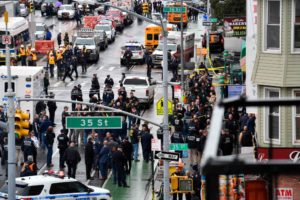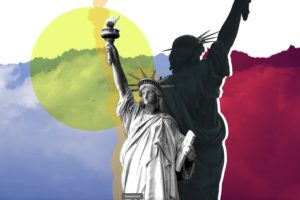|
Getting your Trinity Audio player ready...
|
Reading Time 6 mins
April 30, 2022

Ambulances lined the streets outside the 36th Street subway station where NYPD responded to a 911 call following rush-hour shootings on the subway at 8:27 am, April 12, 2022. multi following a rush-hour shooting in a Brooklyn subway.
I am a native New Yorker. Brooklyn-born in 1979 (to Trinibagonian and Jamaican parents), and except for a brief stint in Washington D.C. to attend Howard University, I now reside in Harlem. Of late, there have been fierce Social Media debates about who is a New Yorker or when a transplant (someone not from New York) can claim they are. Five years? Ten years? Or is it based on experience or nuanced knowledge of train stations, neighborhoods, and codes of conduct?
For example. A ‘real’ New Yorker would never refer to train lines by color. Greenline? Do you mean the 4/5/6? A ‘real’ New Yorker would never refer to a neighborhood by an acronym BoCoCa – you mean Brooklyn Heights, Carol Gardens, and Borem Hill? Or my personal favorite is shortening Washington Heights to WashHeights or South Harlem to SoHa. I love New York. The confluence of cultures and parades ranging from St. Patrick’s Day to the West Indian Day Carnival pon de parkway means there’s never a dull moment. And to my surprise, a mundane trip to Queens was more than hearing various languages and smelling multiple aromas.
On Tuesday, April 14th, I awoke around 7 am, excited to attend a conference for arts educators to explore new methods and meet and collaborate with new people and institutions. After weeks of below-average weather, the forecast was sunny in the low 70s. My trip from Harlem would take about an hour and a half to get to Queens Museum, famous for the colossal globe built to host the 1964-65 World’s Fair.
After Donald Trump became president in 2016, I decided to turn on notifications for news alerts, but I’ve also strived to balance that with meditation, usually in vain. But on 4/12, I woke up determined to curate my day with peace. First, I listened to a guided meditation and then to the soothing reggae rhythms of Maxi Priest. Next, I saw a notification from Clubhouse (the only social media app that I allow notifications) that said, “A bomb in NYC; I told y’all the end is near!” I thought it was yet another alarmist room to gain attention and followers. On entering the subway, I used my phone to Apple Pay my fare and waited for a 2/3 train headed towards Times Square.
NYC: Resurrection or Drown in a Flood of Violence?
I turned on WNYC’s Brian Lehrer for his usual engaging parlance while discussing issues when he broke form and sounded more on edge. He was always adept at being intentional and emotionally intelligent. Yet, at that moment, his tone was guarded and urgent as he segued into breaking news about a possible mass shooting. What? On the train?
I was already past 96th street. Do I turn back? I decided to continue my journey while listening keenly for updates and assiduously checking for news notifications. I received none. I would be a one-percenter if I received a dollar for all the Will Smith, JLo, and Ukraine notifications. But for some reason, the biggest breaking news story in years transpires, and I hear about it sparingly in between train stops underground?
Was this terrorism? Was this orchestrated, and more attacks would plague various parts of NYC? I had no idea, but I hoped for the best though I heard that the man was still on the run. The conference (though sparsely attended for obvious reasons) was an enlightening experience worth the trek and the risk but will NYC experience a similar happy ending? Although the assailant was eventually apprehended, a more significant threat looms.
The Trauma Class – A Canary in the Coal Mine?
You don’t have to be an economist to know the differences between the upper, middle, and working classes. These classifications can vary by region based on the cost of living and access to resources. Still, generally speaking, the lower your rank, the less money, quality education, health coverage, etc., you can access.
Though some say we live in a meritocracy and stress education as a pathway to success, generally speaking, it is tough to advance out of poverty or even the middle class. And it has been getting more difficult over the past 30 years due to vast income inequality, stagnant wages, college debt, exporting jobs, automation, the gig economy, and rising housing costs. Couple this with a hyper fixation on celebrities, constant adoration of the mega-wealthy, including Musk and Bezos, and a dizzying flurry of game, reality, and talent shows that drown the ugly truths we ignore.
Census.gov reports that poverty is increasing, holding 11.4% of all Americans and an alarming 19.5% of African-Americans in a revolving door of unsustainability. Poverty makes food, water, shelter, and childcare a quest like Survivor–a real-life Darwinian disaster capitalist nightmare. In 2020, there were 37.2 million people in poverty, approximately 3.3 million more than in 2019.
Indeed, most low-wage workers receive no health insurance, sick days, or pension plans from their employers. As a result, they can’t take off work if they get ill and have little hope of retiring with security. This situation leads to health care inequity. In addition, too many people have no choice but to use the emergency room as their primary health provider because they cannot afford regular doctor visits or screening.
While this stone soup of statistics might seem overwhelmingly unsexy compared to a Marvel movie, the consequences are more horrifying than anything Hollywood could stuff into a three-hour dystopian film with a budget of 100 million dollars. While Hollywood fetishizes suffering ranging from slavery movies to the zombie apocalypse, fact is proving to be stranger than fiction, as the headlines and YouTube videos of Frank James, the alleged subway shooter, highlight. A Pandora’s Box right under our nose of abuse and victimization exists on social media with one click. Over several years, we can see and hear Frank create a digital 95 Thesis, critiquing systemic racism while piecing together and articulating his version of A Narrative of Frederick Douglas.
James described how he perceived himself to be in bondage in uncanny detail. From being institutionalized for mental health issues and observing that he left the facility worse than when he entered, plus his grievances with Mayor Adams, Black women, and White America, James wasn’t just crying in the wilderness; he was the canary in the coal mine. Frank James, a man who entered a Brooklyn train station in disguise and walked out of the bloody melee unscathed and plain-clothed, is the poster child for The Trauma Class.

Statue of Liberty. Photo illustration by Slate. Photos by Bryan R. Smith/AFP/Getty Images; John Moore/Getty Images.
The Trauma Class is a growing sector of society, bred in America’s caustic flavor of capitalism that discards humanity while extorting labor and lack of benefits in equal measure. The Trauma Class are the 21st century’s “Huddled masses yearning to breathe free… Send these, the homeless, tempest-tost” to slaughter. And add those addicted to opioids, the homeless, veterans, un-and -un-der employed, the mentally ill, the incels and add to that, those suffering from long covid plus all the children grieving the loss of a parent due to COVID19, to the list. But unlike the poem enshrined on the Statue of Liberty, there is no “lamp beside the golden door!” For this reason, the Trauma Class are also discouraged, cynical and lacking faith that government or other entities will save them or care about their humanity.
The Trauma Class doesn’t see government interventions. Instead, they see politicians eager for photo ops and to give tax inducements to billionaire NFL owners. (Witness Governor Hochul’s $1.1 billion sweetheart deal to the Buffalo Bills and Mayor Adams’ homeless encampment sweeps numbering in the 300s while only five have entered the shelter system). As a result, the Trauma Class is raw and increasingly enraged.
Will the rise in the Trauma Class mean more shootings and chaos? Maybe. The issue isn’t that finite and predictable, for the Trauma Class will erupt randomly: Roaming the streets, stealing to survive, shooting, or creating an invisible threat. Sounds familiar? Hollywood has been grooming us for this dystopia for years but, unlike movies, we can control our destiny. So what are you willing to do to protect and prevent the ever-increasing trauma class? Let’s start by asking our government, “who do you protect, and who do you serve?”
Kanene A. Holder has written for HuffPost, Everybody’s, Black Book Review, and BigDrumNation among others. Holder has produced shows about race relations at The Public Theater’s Joe’s Pub and served as Art Department Chair at Broome Street Academy, a high school for homeless and LGBTQA youth, and a theater teacher at The Schomburg Center for Research in Black Culture. Currently, she is a Diversity Consultant and AntiRacistPersonalTrainer.

What a pleasantly draped glimpse beneath, yet beyond, the surface of inescapable poverty crying out aloud for studious attention to the “Trauma Class” of the blossoming Frank James folks! In short and with urgency this piece is a wake-up call to treat the deep-seated traumatic malady inevitably and virally infecting the Frank James folks spotted everywhere.
Very nice article, young lady. Your approach reminds me of my time in Moscow, USSR. In my travels on the rails to my classes I ensure that I got the details down such as date, time, place, cost… When I had the time, I expanded on these with my discoveries, feelings and learnings. And, of course, I expand further as I turned my journal entries into developing stories.
My point is that you write like a true journalist. I like this concept of the trauma class. I google it, realize that there is no earlier note of it. So I realize that it is your formulation. Brilliant! This is so appropriate to capture this moment of multilayered collective crises. Seemed back in the days these people like that would emerge every few years – Larry Davis, Bernard Goetz, Colin Furgusson, etc.. Frighteningly, today it seems like every few months. Frank James adds to the list. You captured the psychosis and the material factors within the capitalist ethos that are leading to these psychoses very well.
Refreshing piece.